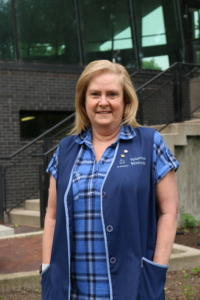As a longtime St. Boniface Hospital volunteer, Joan Lachance never thought she would experience cardiac care at the Hospital as a patient. However, fate had other plans.
Lachance, 61, of Winnipeg, started volunteering at St. B more than 10 years ago, after her mother died in Palliative Care at the Hospital. “After she passed, I wanted to give back somehow,” explained Lachance. “Volunteering was my way of doing that.”
From greeting patients and visitors at the front entrance, to delivering complimentary copies of the Free Press to patients throughout the facility, Lachance has embraced her volunteer role at the Hospital.
She has also been busy helping out in her community. “I volunteered a lot with ringette for more than 20 years,” said the former full-time mom to two daughters, now 30 and 34 years old.
High blood pressure marked a health issue
It should come as no surprise to the reader that Lachance and her husband, Don, were out volunteering for the Transcona Optimist Club’s Santa Claus Sleigh one night in December of 2024.
“Don and I were marking the sleigh route to post later on Facebook,” said Lachance. “We came home, and I just felt off. I had zero pain in my chest, but I wasn’t feeling well. I can’t describe it except to say a bit of heart racing and shortness of breath. Something just didn’t seem right,” she continued.
Lachance has a blood pressure machine at home, so she took a reading. “It was 200 over 98, which is high,” she remembered. She recovered from a stroke at age 39 and was cautious about her health.
Still, she had doubts. “My first thought was, I know they’re busy in the Emergency Department. Do I want to go there and waste their time if I’m not unwell? To me, it did not yet feel urgent,” she said. Eventually she and Don decided to go after all.
At St. Boniface Hospital, Lachance had a blood test to check her troponin, a protein that signals heart muscle damage. It was high. “While a normal reading is 14 and under, mine was about 35,” she explained. For the next three hours she waited in Emergency, until another blood test showed her troponin had spiked to 300.
The physician on duty admitted Lachance to the Cardiac ward and booked her for an angiogram the next day, adding her to nearly 47,000 patient visits made to the Hospital’s Cardiac Sciences program each year. She would be at St. B for four nights.
The angiogram showed Lachance had no blockages, which was lucky, but also that she had experienced a spontaneous coronary artery dissection (SCAD) heart attack. SCAD is a condition in which a small tear forms within an artery wall in the heart. It can lead to blood flow problems, heart attack, abnormalities in heart rhythm, and even death.
“For me, SCAD was a little tear, sort of like a bruise, in my artery,” said Lachance. “Blood pumps through the artery, but it’s bumping that bruise every time. So, it takes time to heal on its own.” She required no surgery.
 Second SCAD in January of 2025
Second SCAD in January of 2025
According to studies, up to 90 per cent of cases of SCAD are in female patients. Researchers know the condition is common in otherwise healthy women under 50 years of age and can also occur during pregnancy. There is a significant gap in scientific knowledge when it comes to heart disease in women as opposed to men, however. St. Boniface Hospital Research is working to close that gap by establishing Manitoba’s first dedicated women’s heart health research program, thanks to donor support.
SCAD can be caused by emotional and stressful situations, physical triggers like resistance and high-intensity training and long-distance running, as a pregnancy complication, hormonal triggers, genetic predispositions, and a condition called fibro muscular dysplasia.
Back at St. B, Lachance’s caregivers gave her blood pressure medication and sent her home on December 22, in time for Christmas. She had an appointment to later see Dr. Shuangbo Liu, an interventional cardiologist and clinician-scientist at St. B, and expert in women’s heart health.
In the first couple of days of the new year, however, Lachance felt pain in her chest. She returned to St. B’s Emergency Department.
The doctor there believed it was another SCAD. “But because of that, they prefer not to do another angiogram to confirm it, because the thin wire could make the tear worse by accident,” Lachance said. She stayed at St. B for another four nights, leaving with a bit more medication.
Dr. Shuangbo Liu explained to Lachance that they would not have treated her any differently with the second SCAD, no matter what an angiogram might have found. She told her about 20 per cent of SCAD patients can have more than one, relatively close to each other.
Healing, back to volunteering at St. B
Today, Lachance still lives with the occasional pain in her chest from her second SCAD. She had not anticipated the psychological burden that came with it. “I went back to the Emergency Department for a third time in late January of 2025, because I had the pain again,” she said.
“It turned out my troponin was low, but it plays on your mental state: is it tearing again? Is it dissecting more? Is it this, is it that? It plays mind games, there’s uncertainty.”
Lachance has happily returned to her volunteer duties at St. B, now with Patient Registration, escorting patients to their appointments.
“Being on the patient end of it, you appreciate the level of care a lot more. Now, if patients share their stories with me while on their way to the Asper Institute or Bergen Cardiac Care Clinic, I can share with them that I, too, am a cardiac patient. I tell them how great my care was, and still is, at St. B.”
“For more than 10 years as a volunteer, people have told me how good the cardiac care is at St. B, whether it’s in Asper, in surgery, the pacemaker clinic – how good everyone is all the way around. My care was absolutely fantastic,” she added.
“I can’t say enough about the care, and I don’t say that because I’m a volunteer. From the health-care aides to our nurses and doctors, they were all fantastic. It makes me even more proud to be a volunteer at St. Boniface Hospital.”


